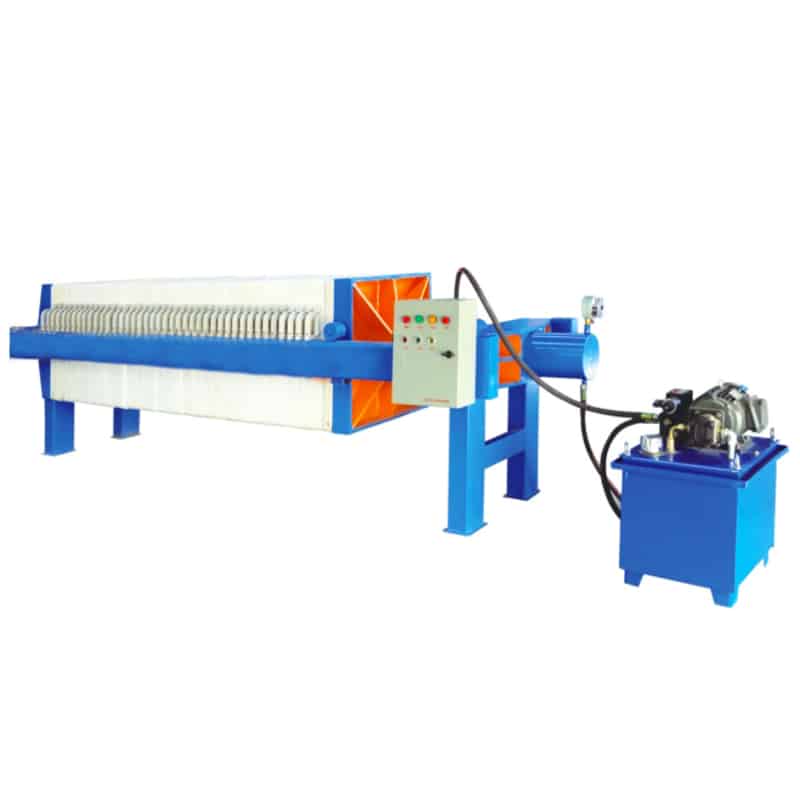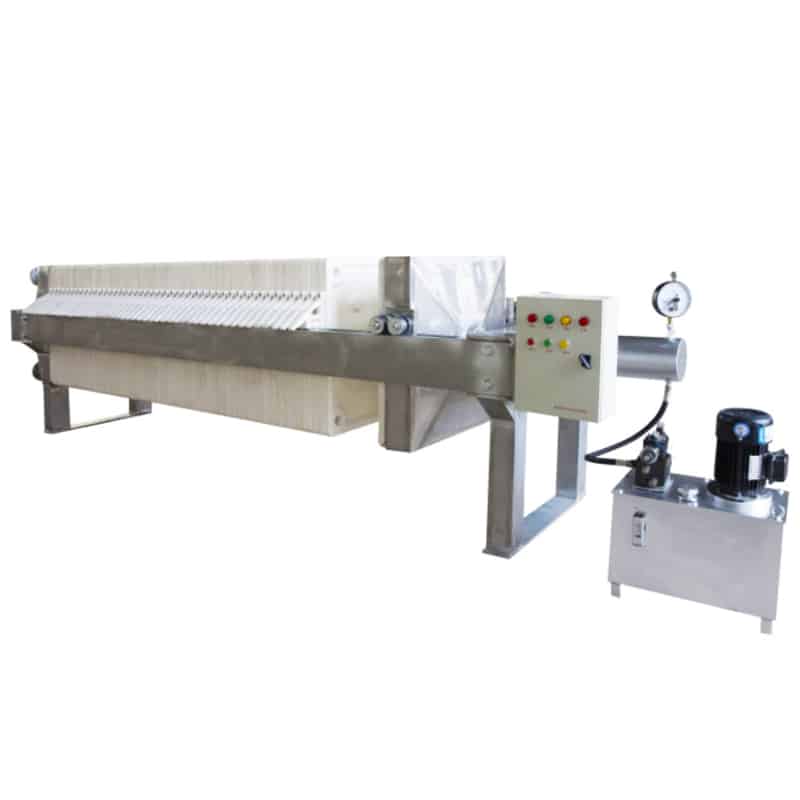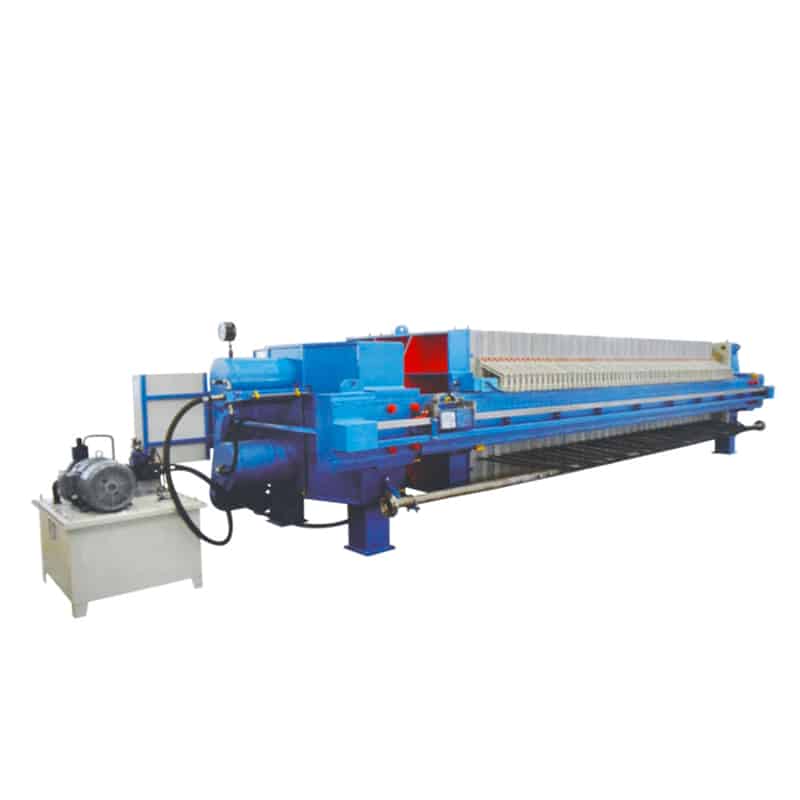Filter press plates are a vital component of filter presses, enabling solid-liquid separation by providing support and separation during the filter press process. They play a key role in a variety of industrial applications, including wastewater treatment, chemical production, mining, food processing, and other areas, helping to achieve efficient solid-liquid separation processes that improve productivity and product quality.
Basic function of filter press plate
The function of the filter press plate in a filter press is to enable the liquid to pass through by creating a fixed pore structure in the solid-liquid mixture, while the solid particles are blocked and concentrated in the space between the filter press plates. The basic principle is to utilize filter media (such as filter cloth or screen) and pressure to filter the liquid in the solid-liquid mixture through the filter press plate, so that the solid particles are separated, thus realizing solid-liquid separation. The main components of the filter press plate include:
- Main plate: Used to support and hold the filter media, it usually has a flat surface to ensure filter press effectiveness and sealing.
- Filter media: the filter material located on the main plate, which may be a filter cloth, screen or other filter media, used to prevent solid particles from passing through while allowing liquid to flow through.
- Feed port: used to introduce the mixture to be filtered into the space between the filter press plates for the filtering operation.
- Drain port: an outlet for discharging solid particles and filtered liquid so that they can be collected separately after separation.
Filter press plates are usually made of corrosion-resistant materials, such as polypropylene (PP) or polypropylene nitrile (PPN), to ensure long-term stable operation in various industrial environments. Their structural design can usually be customized to meet different filter press models and application requirements to meet different filtration requirements.
Different types of filter press plates
Corrosion-resistant polypropylene filter plate
Structure:
Corrosion Resistant Polypropylene Filter Plates are mainly made of polypropylene material with flat surface and sturdy structure. They are usually made of corrosion-resistant polypropylene material to ensure long-term stable operation in corrosive liquid environments. The surface of the filter plate is covered with a filter medium, such as a filter cloth or screen, which is used to stop solid particles from passing through while allowing liquid to flow through.
Corrosion-resistant polypropylene filter plates offer many features and advantages that make them widely used in a variety of industrial applications:
Corrosive resistance: Polypropylene materials have good corrosion resistance and are able to withstand acids, alkalis and other chemicals, making them suitable for use where corrosive liquids are handled.
Chemical stability: polypropylene filter plate has good chemical stability, not easily affected by chemical substances and changes, to maintain its original performance and stability.
High temperature resistance: polypropylene material has good high temperature resistance, can be stable in high temperature environment, not easy to soften or deformation.
Light weight and high strength: Polypropylene filter plate has a low density and high strength, so that it has excellent mechanical properties and wear resistance, can withstand greater pressure and impact.
Easy to clean and maintain: The surface of polypropylene filter plate is smooth and even, not easy to adhere to solid particles, easy to clean and maintain, prolonging the service life.
Economically practical: Compared with other materials, polypropylene filter plate has lower cost, simple manufacturing process, easy to process and customize, which makes it an economical and practical choice.
Applications:
Corrosion-resistant polypropylene filter plates are widely used in a variety of demanding industrial applications, especially for handling corrosive liquids, such as:
- Chemical industry
- Iron and steel smelting
- Electroplating industry
- Mining industry
- Wastewater treatment, etc.
Diaphragm extruded (membrane) filter plate
Structure:
Diaphragm extrusion filter plates usually consist of three main parts: the main plate, the diaphragm and the filter cloth. The main plate is similar to an ordinary filter press plate and is used to support and hold the membrane and cloth in place. The diaphragm is located between the main plate and the filter cloth and acts as a separator and can be deformed by pressure. The filter cloth covers the surface of the diaphragm and is used to filter liquids in solid-liquid mixtures.
Principle of operation:
During the filter press, the mixture to be filtered enters the space where the diaphragm squeezes the filter plate through the inlet. Subsequently, by applying pressure, the diaphragm contracts or expands, compacting the solid particles and separating them, while the liquid is gradually squeezed out through the diaphragm and filter cloth. This process of diaphragm extrusion enables higher filtration efficiency and solid-liquid separation.
Applications:
Diaphragm extrusion filter plates are widely used in many industrial applications, especially where efficient solid-liquid separation and drying is required. Common applications include:
- Mining: for the extraction of solid particles from metallic minerals.
- Chemical: for processing chemicals containing high concentrations of solids.
- Food Processing: For the extraction of liquid components from food ingredients.
- Pharmaceutical: For purification processes in the preparation of pharmaceuticals.
In addition to corrosion-resistant polypropylene filter plates and diaphragm extrusion (membrane) filter plates, there are several common types of filter platens, including:
Metal filter plate: metal filter plate is usually made of stainless steel or cast iron and other metal materials, with high temperature resistance, corrosion resistance, suitable for processing high temperature or corrosive substances occasions.
Rubber extruded filter plate: rubber extruded filter plate is made of rubber material, with good elasticity and sealing, suitable for the strict requirements of the filter media occasions.
Multi-layer filter plate: Multi-layer filter plate is composed of multiple layers, which can improve the filtration efficiency and processing capacity, and is suitable for the treatment of high-concentration solid-liquid mixtures.
Membrane filter plate: The membrane filter plate is covered with a layer of membrane material on the filter cloth, and the membrane is expanded by applying pressure to improve the filtration efficiency, which is suitable for the occasions requiring high-precision filtration.
Toothed filter plate: The surface of the toothed filter plate has a certain number of toothed grooves, which can increase the filtration area and solid-liquid separation effect, and it is suitable for processing materials with large particles.
Composite material filter plate: The composite material filter plate is made of a combination of various materials, combining the advantages of various materials, and is suitable for filtration needs in various special working conditions.
Filter press plates for different applications
In the mining industry, filter platens play a key role in solid-liquid separation. They need to be designed to meet special requirements, such as wear and corrosion resistance, to cope with the challenges posed by the high hardness of the ores and chemicals used in the mining process. At the same time, filter platens need to be designed with large dimensions and high pressure capacity to handle large volumes of ore and waste to ensure the efficient operation of the mining process.
In the wastewater treatment process, the corrosion resistance and filtration efficiency of filter platens are critical. As wastewater contains a variety of chemicals and corrosive substances, the filter platen needs to have good corrosion resistance, while maintaining high filtration efficiency to ensure the effective separation of solids and liquids, purify wastewater, and meet environmental requirements.
In the battery recycling process, filter platens need to have excellent acid and alkali resistance and diaphragm design. Considering that the battery recycling process often involves the treatment of acidic and alkaline solutions, the filter platen needs to be made of materials with good acid and alkali resistance, and the diaphragm needs to be designed efficiently to ensure stable operation and efficient solid-liquid separation, and to improve the efficiency and yield of the battery recycling process.
Advantages and disadvantages of concave chamber design and diaphragm extrusion (membrane) design
Concave chamber design
Advantages:
High capacity: The chamber design of the filter platen usually has a large filtration area, which is able to handle more solid-liquid mixtures and improve the processing capacity and productivity.
Strong stability: the structure of the chamber design filter platen is stable, not easy to deform, can withstand greater pressure, and maintain stable filtration effect.
Easy to clean: The surface of the filter platen with concave chamber design is flat, not easy to accumulate solid particles, easy to clean and maintain, and prolong the service life.
Disadvantage:
More prone to clogging: The chamber design of the filter platen is prone to solid particle accumulation during the filtration process, which may lead to clogging and affect the filtration efficiency.
Higher cost: Recessed design filter platens usually require more materials and processing, resulting in higher costs.
The chamber filter press has a chamber design for the filter plate. The chamber plates are generally made of high-strength polypropylene and offer high performance. The type of suspension to be filtered (e.g. mining, chemical or pharmaceutical industries) is irrelevant.


Diaphragm extrusion (membrane) design
Advantages:
Precise control: The diaphragm squeeze (membrane) design of the filtration platen enables precise control of the filtration process by adjusting the pressure of the membrane, improving filtration efficiency and product quality.
Prevents clogging: The squeezing action of the membrane effectively prevents solid particles from accumulating and clogging during the filtration process, maintaining high filtration efficiency.
Wide applicability: The diaphragm squeezing (membrane) design of the filtration platen is suitable for processing solid-liquid mixtures with different particle sizes and characteristics, and has strong versatility.
Disadvantages:
Higher costs: Diaphragm-extruded (membrane) design filter platens typically require more complex structures and control systems, resulting in higher costs.
Increased susceptibility to wear and tear: The squeezing action of the membrane can lead to damage and wear of the membrane material, requiring periodic replacement and maintenance, increasing operating and maintenance costs.
The membrane filter press has a significant impact on the dryness of the solids through the use of membrane technology in the filter plate. It achieves the lowest residual moisture values in the filter cake compared to conventional filtration processes.


Summary
The importance of filter press plates in filter presses cannot be overstated, they are the key components to realize solid-liquid separation and are widely used in mining, chemical industry, wastewater treatment and other fields. Choosing the right type and design of filter press plate directly affects the efficiency of the filter press process and product quality. Therefore, the selection of the right filter press plate is essential for the proper operation of the filter press and the smooth running of the process.
KUOSI offers various types of filter presses, as well as sludge dewatering equipment, sludge dryer equipment, dosing systems, blowers, disinfection systems and wastewater screens. Please consult us if you have questions.
